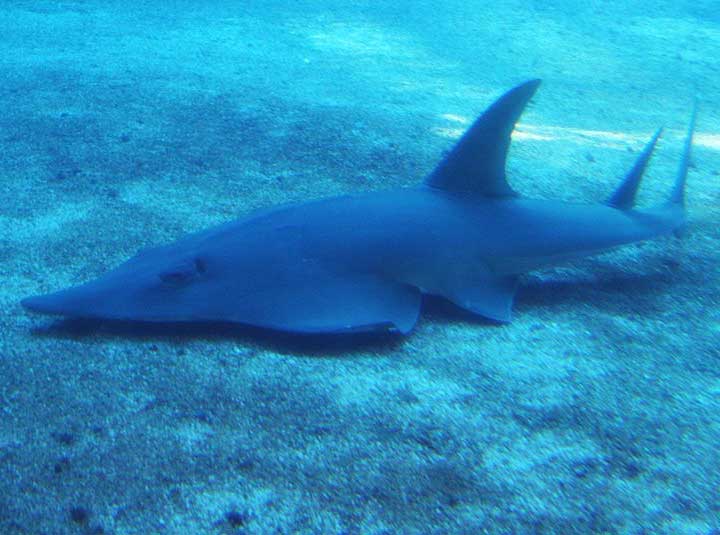
Rhynchobatus djiddensis (*)
Superregnum: Eukaryota
Cladus: Unikonta
Cladus: Opisthokonta
Cladus: Holozoa
Regnum: Animalia
Subregnum: Eumetazoa
Cladus: Bilateria
Cladus: Nephrozoa
Superphylum: Deuterostomia
Phylum: Chordata
Subphylum: Vertebrata
Infraphylum: Gnathostomata
Classis: Chondrichthyes
Subclassis: Elasmobranchii
Infraclassis: Euselachii
Division/Cohort: Neoselachii
Subdivision/Subcohort: Batoidea
Superordo: Batomorphii
Ordo: Rhinopristiformes
Familia: Rhinobatidae
Subfamilia: Rhynchobatinae
Genus: Rhynchobatus
Species: Rhynchobatus djiddensis
Name
Rhynchobatus djiddensis (Forsskål, 1775)
Etymology: –ensis, suffix denoting place: Djidda (now Jedda), Saudi Arabia, on Red Sea, putative type locality. (From: The ETYFishproject)
Synonyms
Raja djiddensis Forsskål, 1775
Rhinchobatus djiddensis (Forsskål, 1775) (misspelling)
Rhinobatus djiddensis (Forsskål, 1775)
Rhynchobatus djeddensis (Forsskål, 1775) (misspelling)
Rhynchobatus djiddenis (Forsskål, 1775) (misspelling)
Rhynchobatus djidensis (Forsskål, 1775) (misspelling)
Rhyncobatis djeddensis (Forsskål, 1775) (misspelling)
Rhyncobatus djeddensis (Forsskål, 1775) (misspelling)
Rhyncobatus djiddensis (Forsskål, 1775) (misspelling)
Rynchobatus djiddensis (Forsskål, 1775) (misspelling)
Rhinobatus maculata Ehrenberg, 1829
?Rhinobates rueppellii Swainson, 1838
Vernacular names
English: Giant guitarfish, Spotted guitarfish
தமிழ்: பல்லுவாய்
ไทย: ปลาโรนันจุดขาว
References
Forsskål, P. S.; 1775: Descriptiones animalium avium, amphibiorum, piscium, insectorum, vermium; quae in itinere orientali observavit... Post mortem auctoris edidit Carsten Niebuhr. Hauniae. 1-20 + i-xxxiv + 1-164, map.
Last, P.R., Séret, B. & Naylor, G.J.P. 2016. A new species of guitarfish, Rhinobatos borneensis sp. nov. with a redefinition of the family-level classification in the order Rhinopristiformes (Chondrichthyes: Batoidea). Zootaxa 4117(4): 451–475. DOI: 10.11646/zootaxa.4117.4.1. Reference page.
Links
Rhynchobatus djiddensis in Catalog of Fishes, Eschmeyer, W.N., Fricke, R. & van der Laan, R. (eds.) 2022. Catalog of Fishes electronic version.
Rhynchobatus djiddensis in FishBase,
Froese, R. & Pauly, D. (eds.) 2022. FishBase. World Wide Web electronic publication, www.fishbase.org, version 08/2021.
Rhynchobatus djiddensis in the World Register of Marine Species
The giant guitarfish (Rhynchobatus djiddensis), also known as the whitespotted wedgefish, is a large species of guitarfish in the family Rhinidae. It is restricted to the Red Sea, Persian Gulf, and western Indian Ocean,[3] but was formerly considered more widespread due to confusion with its relatives.[1]
Taxonomy and range
The giant guitarfish was previously believed to range throughout a large part of the Indo-Pacific, but recent evidence has shown that it, as traditionally defined, actually was a species complex consisting of four different species.[4] In addition to the giant guitarfish, this complex includes the white-spotted guitarfish, the broadnose wedgefish and possibly the smoothnose wedgefish. With these as separate species, the giant guitarfish has a relatively restricted range; it is found only in the Red Sea and Persian Gulf, and the western Indian Ocean as far south as South Africa.[3][5]
Description
A large fish reaching up to 3.1 m (10 ft) long and weighing as much as 227 kg (500 lb),[5] it is brownish or greyish above with a variable pattern of white spots. Juveniles have a black spot above each pectoral fin, but in adults it is a dusky ring or absent. There is a dark, bar-like pattern between the eyes (on top of the head), which separates it from the other Rhynchobatus species in its range.[3]
Behavior
Breeding
It is ovoviviparous, and a female can give birth to litters of up to 10 young.[5][6]
Diet
The giant guitarfish feeds on bivalves, crabs, lobsters, squid and small fish.[5][6] Despite not having any cutting teeth, this species is a known predator of stingrays. One specimen from the Philippines had more than 20 stingray barbs stuck in its jaw, apparently unaffected by the stingray's venom.[7]
Ventral view.
Habitat
It is a shy fish, found at depths of 2–50 m (6.6–164.0 ft), inhabiting areas with a sandy sea floor. These are generally around coastal reefs or reef flats, but they will sometimes venture into the brackish waters of estuaries.[5][6]
Interaction with man
The giant guitarfish is harmless to humans. It is listed as critically endangered on the IUCN Red List as its population is believed to have declined significantly due to unregulated high levels of exploitation for its flesh and fins,[4] the latter for shark fin soup. Its low fecundity and presumed slow growth rate make it highly vulnerable to unsustainable exploitation.[4]
References
Kyne, P.M.; Gledhill, K.; Jabado, R.W. (2019). "Rhynchobatus djiddensis". IUCN Red List of Threatened Species. 2019: e.T39394A121035795. doi:10.2305/IUCN.UK.2019-2.RLTS.T39394A121035795.en. Retrieved 18 November 2021.
"Appendices | CITES". cites.org. Retrieved 2022-01-14.
Last; White; de Carvalho; Séret; Stehmann; Naylor, eds. (2016). Rays of the World. CSIRO. pp. 68–75. ISBN 9780643109148.
Kyne, P.M., Gledhill, K. & Jabado, R.W. 2019. Rhynchobatus djiddensis. The IUCN Red List of Threatened Species 2019: e.T39394A121035795. https://doi.org/10.2305/IUCN.UK.2019-2.RLTS.T39394A121035795.en. Downloaded on 26 July 2019.
Froese, Rainer; Pauly, Daniel (eds.) (2007). "Rhynchobatus djiddensis" in FishBase. 7 2007 version.
Lieske, E. and Myers, R.F. (2004) Coral reef guide; Red Sea London, HarperCollins ISBN 0-00-715986-2
Pavid, Katie. "The cannibal rays that eat fellow fish". Natural Science Museum.
Retrieved from "http://en.wikipedia.org/"
All text is available under the terms of the GNU Free Documentation License

